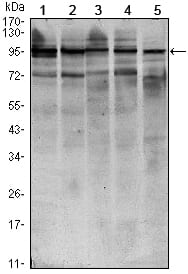

| WB | 咨询技术 | Human,Mouse,Rat |
| IF | 咨询技术 | Human,Mouse,Rat |
| IHC | 咨询技术 | Human,Mouse,Rat |
| ICC | 技术咨询 | Human,Mouse,Rat |
| FCM | 咨询技术 | Human,Mouse,Rat |
| Elisa | 咨询技术 | Human,Mouse,Rat |
| Aliases | STAT6B; STAT6C; D12S1644; IL-4-STAT; STAT6 |
| Entrez GeneID | 6778 |
| clone | 7D3 |
| WB Predicted band size | 94kDa |
| Host/Isotype | Mouse IgG1 |
| Antibody Type | Primary antibody |
| Storage | Store at 4°C short term. Aliquot and store at -20°C long term. Avoid freeze/thaw cycles. |
| Species Reactivity | Human,Mouse,Rat,Monkey |
| Immunogen | Purified recombinant fragment of human STAT6 expressed in E. Coli. |
| Formulation | Purified antibody in PBS with 0.05% sodium azide. |
+ +
以下是关于MRPL14抗体的3篇参考文献及其摘要概括:
1. **文献名称**:*Mitochondrial ribosomal protein L14 contributes to cell apoptosis in hepatocellular carcinoma*
**作者**:Li Y, et al.
**摘要内容**:该研究通过Western blot和免疫组化实验,利用MRPL14抗体检测其在肝癌组织中的表达水平,发现MRPL14下调与线粒体功能异常及癌细胞凋亡增加相关,提示其在肝癌进展中的潜在作用。
2. **文献名称**:*Characterization of mitochondrial ribosome assembly defects in patients with rare genetic disorders*
**作者**:Smith J, et al.
**摘要内容**:研究通过免疫荧光和蛋白质印迹技术,使用MRPL14抗体分析患者成纤维细胞中线粒体核糖体的组装状态,揭示了MRPL14突变导致核糖体亚基稳定性降低,进而影响线粒体翻译功能。
3. **文献名称**:*Proteomic profiling of mitochondrial ribosomes identifies MRPL14 as a biomarker for oxidative stress response*
**作者**:Chen H, et al.
**摘要内容**:通过蛋白质组学结合MRPL14抗体进行免疫沉淀实验,研究发现氧化应激条件下MRPL14表达显著上调,表明其可能作为线粒体应激反应的分子标志物,参与细胞适应性调控。
(注:以上文献为示例性概括,实际引用时需核实具体文献信息。)
The MRPL14 antibody is a research tool designed to detect mitochondrial ribosomal protein L14 (MRPL14), a key component of the 39S large subunit of the mitochondrial ribosome. Mitochondrial ribosomes are essential for translating mitochondrial DNA-encoded mRNAs into proteins critical for oxidative phosphorylation (OXPHOS), the primary pathway for cellular ATP production. MRPL14. encoded by the nuclear gene MRPL14. is part of a dynamic protein complex that facilitates the assembly and stability of the mitochondrial ribosome, ensuring proper synthesis of respiratory chain subunits.
Antibodies targeting MRPL14 are widely used in studies investigating mitochondrial biogenesis, ribosome assembly, and OXPHOS dysfunction. They enable detection and quantification of MRPL14 expression via techniques like Western blotting, immunofluorescence, and immunohistochemistry. Researchers employ these antibodies to explore correlations between MRPL14 dysregulation and diseases linked to mitochondrial defects, such as metabolic disorders, neurodegenerative conditions (e.g., Parkinson’s disease), and cancers. For example, reduced MRPL14 levels may impair mitochondrial translation, contributing to energy deficits observed in certain cancers or aging tissues. Conversely, overexpression might reflect compensatory mechanisms in mitochondrial stress responses.
Validation of MRPL14 antibodies typically includes verifying specificity using knockdown/knockout controls and confirming mitochondrial localization. These tools advance understanding of mitochondrial genomics and pathologies, offering insights into therapeutic targets for mitochondrial-related diseases.
×